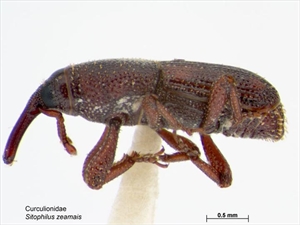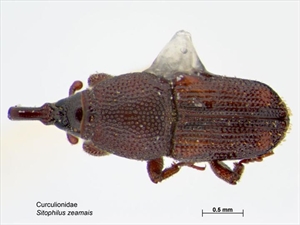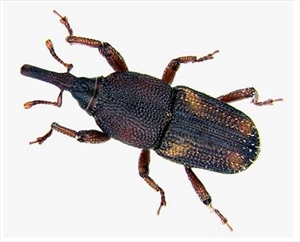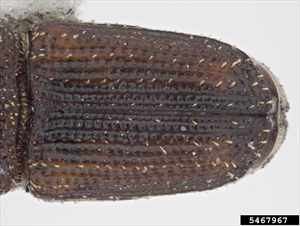- Worldwide distribution. On rice, maize, sorghum, wheat, cassava, and other stored products. A destructive weevil.
- Attacks sound grains, leaving large cavities, and allowing secondary invasions by insects, mites, and fungi. Infestations can start in the field.
- Eggs laid in holes chewed in grain, then plugged. Larvae feed inside the grain, and pupate there. Adults, up to 4 mm long, reddish-brown to black with four light-reddish to yellowish spots on the wings.
- Spread with movement of stored grain; on the wing - the weevils are strong flyers.
- Cultural control: harvest at maturity; dry to 12%; keep storage rooms and areas clean; spray bins, and use new sacks; if infestations occur, locate and treat: if small - sieve, freeze or wrap in plastic and bury; if large - fumigate. Store small amounts of grain in plastic containers.
- Chemical control: consult full fact sheet for details, and always check whether the product is for treating equipment, bins and buildings, or for treating grain for human use and animal feed. READ THE INSTRUCTIONS.
Pacific Pests, Pathogens and Weeds - Online edition
Pacific Pests, Pathogens, Weeds & Pesticides
Maize (greater grain) weevil (339)
Maize weevil, greater grain weevil, greater rice weevil
Sitophilus zeamais
AUTHOR Grahame Jackson
1Information from Swaine G (1971) Agricultural Zoology in Fiji. Her Majesty's Stationery Office. London; and CABI (2019) Sitophilus zeamais (greater grain weevil). Crop Protection Compendium.(https://www.cabi.org/cpc/datasheet/10926); and BioNET-EAFRINET Keys and Fact Sheets. (http://keys.lucidcentral.org/keys/v3/eafrinet/maize_pests/key/maize_pests/Media/Html/Sitophilus_zeamais_Motschulsky_1855_-_Maize_Weevil.htm); and from Maize weevil. Wikipedia. (https://en.wikipedia.org/wiki/Maize_weevil). Photos 1,2&4 MAF Plant Health & Environment Laboratory (2011) Maize Weevil (Sitophilus zeamais): PaDIL - http://www.padil.gov.au. Photo 2 Georg Goergen, IITA-Benin.
Produced with support from the Australian Centre for International Agricultural Research under project PC/2010/090: Strengthening integrated crop management research in the Pacific Islands in support of sustainable intensification of high-value crop production, implemented by the University of Queensland and the Secretariat of the Pacific Community.







